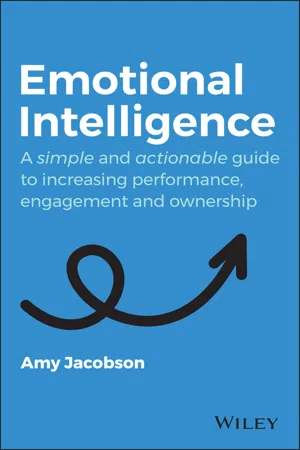
Emotional Intelligence
A Simple and Actionable Guide to Increasing Performance, Engagement and Ownership
- English
- ePUB (mobile friendly)
- Available on iOS & Android
Emotional Intelligence
A Simple and Actionable Guide to Increasing Performance, Engagement and Ownership
About this book
BoostEmotional Intelligence in anysituation to achieveexceptional results for anyorganisation
Asorganisationsaround the world areputting morefocus on the mindset and wellbeing of staff, the need to develop Emotional Intelligence (EI) has never been greater.Emotional Intelligence in the workplace—including the five key concepts of self-awareness, self-regulation, empathy, social skillsand motivation—is defined as yourability to identify and manage your personal emotions and the emotions of your colleagues and co-workers.Emotional Intelligenceisin high demandandis expected tobecomeanessentialcomponentof successin the future of work. Emotional Intelligence: A Simple and Actionable Guide to Increasing Performance, Engagement and Ownership is designed tohelp you master EI andempoweryoutoachieve the very best outcome for everyonein yourorganisation.
Cutting through the hype and dispelling the myths about EI, this practical, easy-to-use resource provides clear guidance, powerful tools, and actionablestepsfor developing and implementing EI in the workplacefor immediate results. Amy Jacobson, an experienced EI specialist, leadership trainer and coach, sharesthe tools, methodologies, concepts and actions that increase EI in any situation.Packed with real-life examples and case studies, insightfulquestions, and usefuldiagrams to create action, this must-have guide:
- Offersa powerful 5-part methodology—Own It, Face It, Feel It, Ask It, and Drive It—tohelp youunderstand and immediately implement Emotional Intelligence principles inbothyour personal and professional life
- IncreasesyourEmotional Intelligence intheworkplace toenable you to inspireandenergisestaff, support empathy and self-awareness, and drive high levels of performance
- Improvesthe way you handle high pressure environments, manage challenging situations, andinteractwithpeoplewithdifferent communication styles
- Helps you solve difficult problems in the workplace such as loss of purpose and engagement, cultural issues, poor communication, and lowproductivity
- Provides concrete steps for eliminatingnegative behaviors andforowningthe role you play, yourimpact on others, andthe decisions and choices youmake
Emotional Intelligence: A Simple and Actionable Guide to Increasing Performance, Engagement and Ownership is an indispensable book for anyoneinteracting with others in the workplace, especially those withleadership rolessuch assenior executives, board members, department heads, managers and supervisors.
Frequently asked questions
- Essential is ideal for learners and professionals who enjoy exploring a wide range of subjects. Access the Essential Library with 800,000+ trusted titles and best-sellers across business, personal growth, and the humanities. Includes unlimited reading time and Standard Read Aloud voice.
- Complete: Perfect for advanced learners and researchers needing full, unrestricted access. Unlock 1.4M+ books across hundreds of subjects, including academic and specialized titles. The Complete Plan also includes advanced features like Premium Read Aloud and Research Assistant.
Please note we cannot support devices running on iOS 13 and Android 7 or earlier. Learn more about using the app.
Information
Part I
What is emotional intelligence?
Chapter 1
The history of emotional intelligence
Emotional intelligence is the ability to perceive emotions, to access and generate emotions so as to assist thought, to understand emotions and emotional knowledge, and to reflectively regulate emotions so as to promote emotional and intellectual growth.
- self‐awareness
- self‐regulation
- internal motivation
- empathy
- social skills.
Chapter 2
Can EI be taught or are we born with it?
EI can be taught. I've taught many people in this field. The key is, you must want to learn it.
Table of contents
- Cover
- Table of Contents
- Title Page
- Copyright
- Foreword
- About the author
- Acknowledgements
- Introduction
- Part I: What is emotional intelligence?
- Part II: Disrupting mindsets using EI
- Part III: The future of EI in the workplace
- Becoming emotionally intelligent
- Index
- End User License Agreement